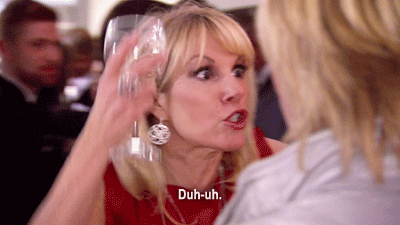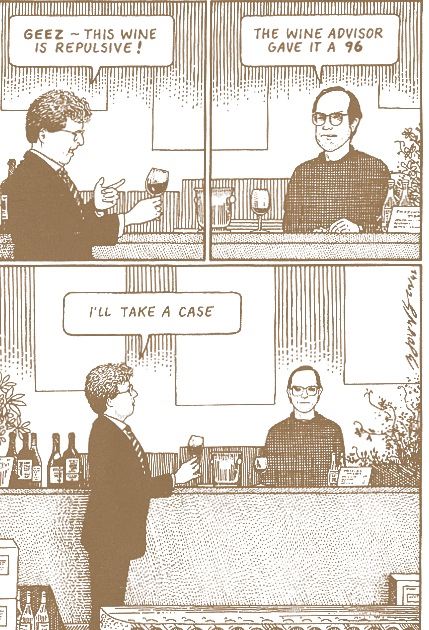Earlier this summer, I was invited to attend a wine tasting event on behalf of one of my clients. The event was billed as a tasting of the “Top 100” wines and, while meeting with the man who had organized the event, I asked him what it meant that a wine was considered a “Top 100.”
Obviously, he told me, they were wines from his portfolio (he ran the wine and liquor division of a local import/distribution company). In addition, each wine had received a score of 90 or higher from the top wine scoring publications – Wine Spectator, Wine Enthusiast, Robert Parker, Stephen Tanzer, etc.
“But you had a say in choosing what to pour too, right?” I asked smiling.
The man blinked at me like I’d just started speaking Chinese. Or a frog had jumped out of my left ear. He stared at me, as though the idea that he would have chosen the wines independently of these sources, according to his tastes, was simply…

And yet, the man struck me as confident and had certainly proved his mettle in the wine world judging by his position and the selection of bottles he’d curated for the company’s brick-and-mortar operation.
It was a strange encounter for me – it had been a long time since I’d stumbled into the company of someone in the industry who was still so fiercely loyal to the powers-that-be in wine scoring.
Most of the industry professionals I know fall neatly (though often begrudgingly) into the millennial generation. When it comes to wine, they are the next generation of influencers, tastemakers, and, ultimately, drinkers. And not a single one of them decides what to pour, sell, or drink based on the scores in last month’s Wine Spectator.
Choosing a wine because it was rated highly by a wine scoring publication is just anathema to the values that drive millennials’ purchasing decisions. Many wine professionals, too, are wary of the scores themselves and are sensitive to the politicking that plays a part in the rating process.
Working in wine PR, I was in a position to really take a good look behind this particular curtain. Wine scores are something that we count on – a high score curries favor with the client and warrants a triumphant press release while a disappointing score sends us shuffling into meetings to discuss how best to proceed.
Much to the chagrin of an industry that has, for years, relied upon the point system developed by Robert Parker (and adopted by subsequent wine scoring publications), to sell their product, this same system has failed to resonate with a millennial audience.
It’s no secret that the scoring publications often favor wines that are more concerned with being technically correct and commercially appealing rather than wines that are interesting, exciting, or unique. They often rate according to reputation rather than quality and it’s much harder to find a 98-point rated Beaujolais than Bordeaux or Burgundy.
All this is not to say that I don’t often sometimes agree with the critics and when I see a beloved bottle awarded a high score I am happy for the producer and feel a little validated.
Going into the Top 100 tasting, however, I wasn’t expecting many surprises and, while I certainly tasted some beautiful wines, I also tasted a lot of what I expected to taste. For me the surprise and adventure of discovery in wine gives me as much pleasure as the indulgence in something classic and perfect.
This, I think, is one of the biggest problems with the wine scoring system – it has, for the most part, failed to evolve and account for the changing palate of a new generation.
Certain critics, such as Robert Parker, have such a very particular preference and palate that it was easy to spot a Parker rated-wine. One would think that Parker’s palate, one that single-mouthedly transformed the industry, would have evolved since he started Wine Advocate in 1975. Yet, at the Top 100 tasting, I could spot a Parker wine from a mile away.

I think this oaky fruit bomb might be a Parker wine…
For older wine consumers, the ones whose palates were developed along with the scoring system, these scores still hold sway – I won’t deny that. And if you asked anyone in sales whether a score can move a boatload of wine, I bet they’d tell you that it doesn’t hurt. Sommeliers and wine directors still take advantage of highly-rated wines, too, marking them up a little higher and using those high scores as a selling point for a certain crowd.
However, when it come to the next generation of influencers, tastemakers, and drinkers, either the system needs to evolve to account for the shifting tastes of younger wine drinkers, or it will soon dissolve into the same arbitrary and antiquated system for consumers that it has already become with so many rising wine professionals.
What do you think? Are you a fan of the easy-to-use point system? Do you think it needs to go the way of the dinosaurs? How does a wine’s score factor into your purchasing decisions?



it is hard to write a short response here as the question is very deep. The point system will stay for a while, as one need some anchors confronted with thousands of different bottles in a typical wine store. Such anchors are labels, point ratings and wine descriptions/shelf takers, but those require more time to comprehend.
The point systems are evolving – it is not only Parker and Spectator anymore – look at all the wine rating publications, blogs and articles – different people rate different wines in a different way, so there is a truth there beyond Parker.
If I can make a side comment – the animated GIFs are extremely annoying…